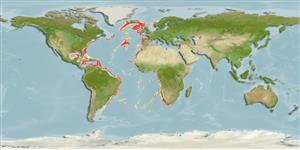Preferred temperature (Ref.
123201): 4.2 - 11, mean 8.4 °C (based on 66 cells).
Phylogenetic diversity index (Ref.
82804): PD
50 = 0.5000 [Uniqueness, from 0.5 = low to 2.0 = high].
Bayesian length-weight: a=0.00282 (0.00118 - 0.00673), b=3.10 (2.89 - 3.31), in cm total length, based on LWR estimates for this (Sub)family-body shape (Ref.
93245).
Trophic level (Ref.
69278): 3.9 ±0.58 se; based on food items.
Daya lenting (Ref.
120179): Rendah, Waktu penggandaan populasi minimum 4.5 - 14 tahun (Assuming Fec <100).
Fishing Vulnerability (Ref.
59153): Moderate vulnerability (40 of 100).
Climate Vulnerability (Ref.
125649): Low vulnerability (5 of 100).
Nutrients (Ref.
124155): Calcium = 19.4 [4.9, 65.6] mg/100g; Iron = 0.455 [0.157, 1.126] mg/100g; Protein = 15.9 [10.2, 18.9] %; Omega3 = 0.354 [0.130, 1.011] g/100g; Selenium = 15.5 [4.8, 53.4] μg/100g; VitaminA = 10.5 [2.1, 47.0] μg/100g; Zinc = 0.367 [0.190, 0.726] mg/100g (wet weight);
